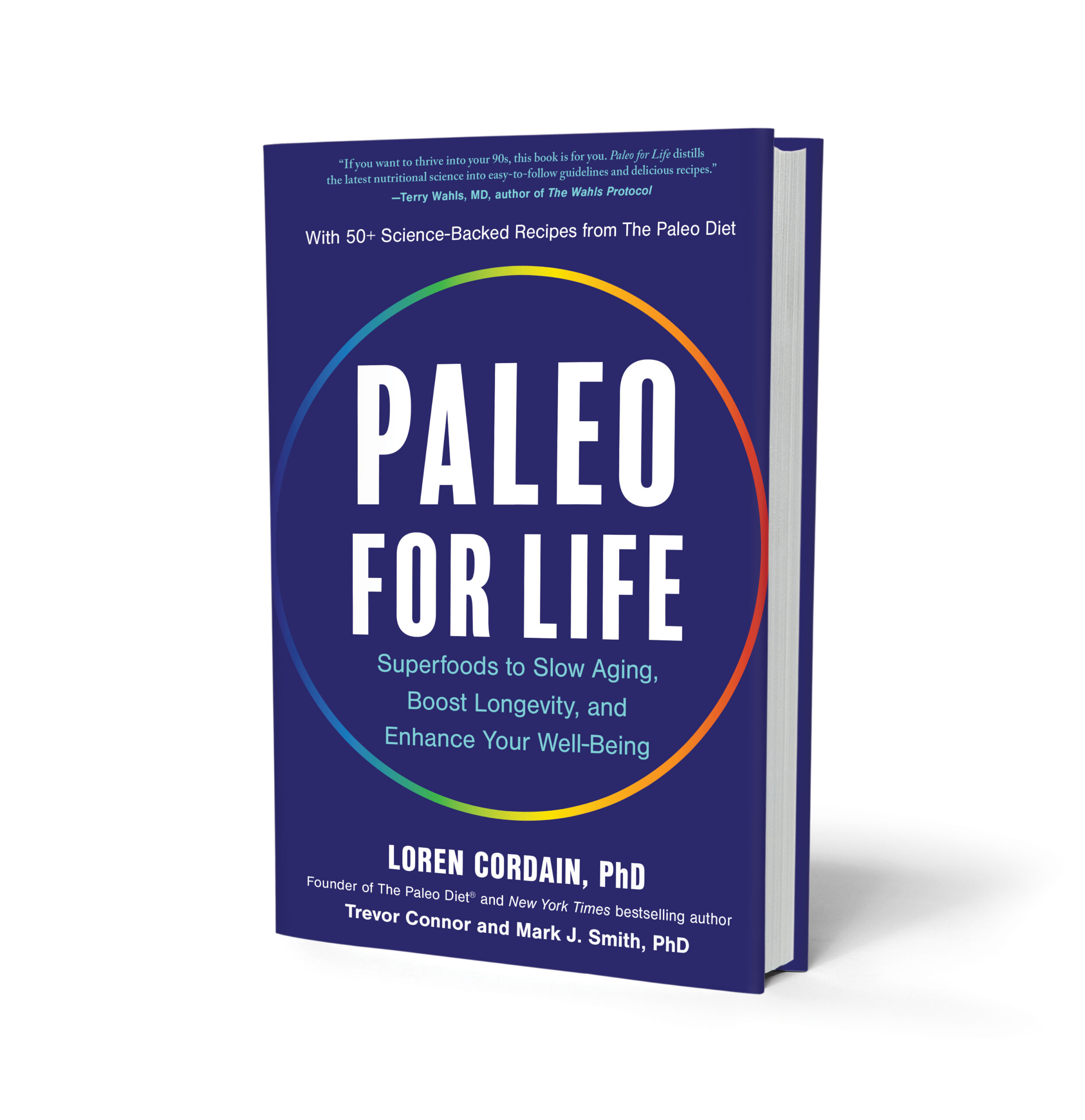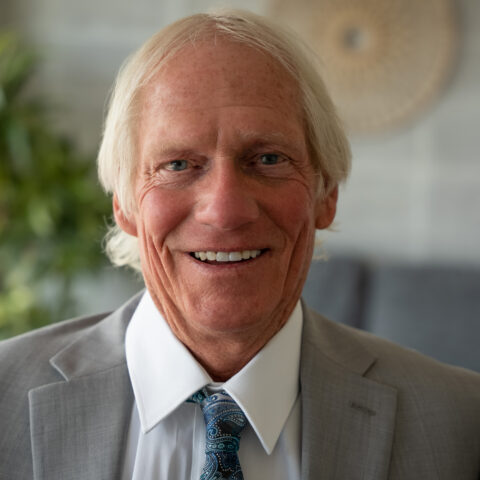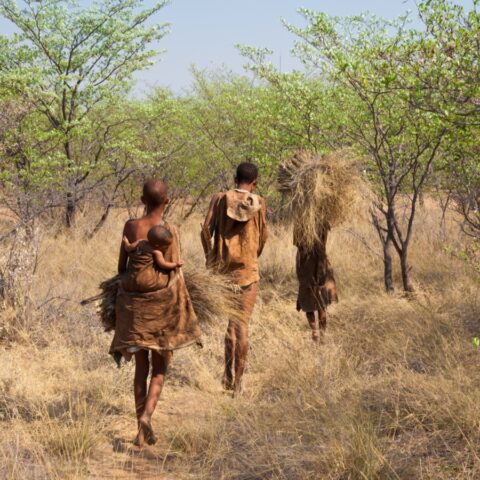The Myth that Hunter-Gatherers Didn’t Live Long
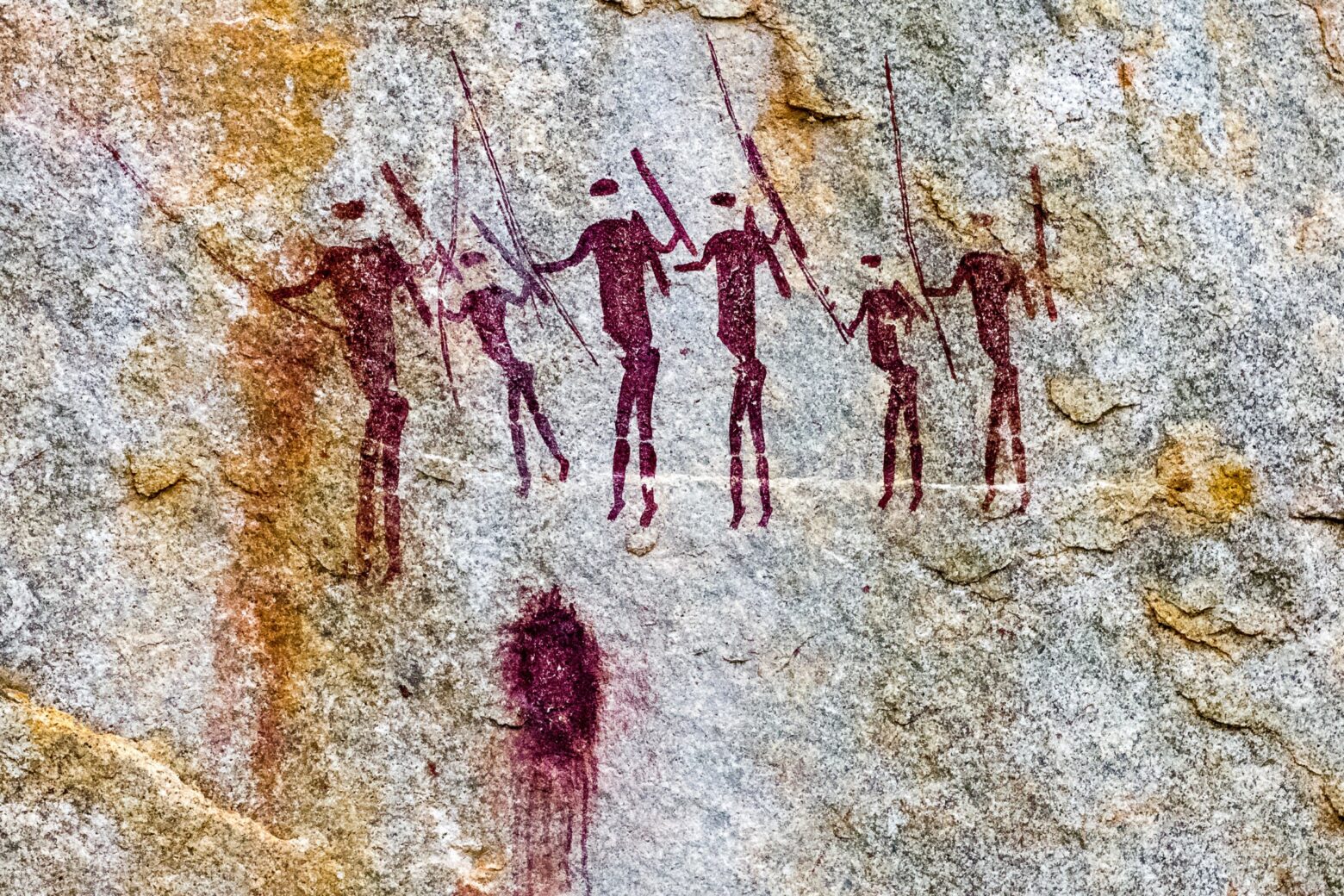
As a fellow Cornellian, I’ve had a long-standing admiration for Bill Nye The Science Guy. Alright, I admit that I was a fan-boy. I was pretty excited when Nye returned to Cornell during my time there, to take a guest professor post. Here was a scientist who was charismatic, made science exciting for the masses, and had the “science chops” to teach at the Cornell science department.
So, I admit that I was disappointed when I watched Bill Nye take on the Paleo Diet in his new Netflix show Bill Nye Saves the World. Don’t get me wrong; I wasn’t disappointed because he criticized the diet. As scientists, we welcome criticism and counter-arguments—it makes the science stronger. No, I was disappointed because this scientist, who I admired, not only presented a poor argument, but demonstrated a fundamental misunderstanding of basic science.
An unedited version of the Bill Nye’s Paleo Diet bit isn’t available outside of Netflix. But here’s two YouTube videos showing parts of it—one for and one against:
Bill Nye Disses Paleo. Says Vegan Is the Future
Bill Nye LIES About The Paleo Diet
I do understand that his show is directed at a young audience, so I can forgive a lot. I can even forgive Nye for dressing an actor in bad animal firs, a club, and steel rimmed glasses (apparently a long-forgotten Paleolithic invention made soon after the discovery of fire) and claiming he’s a paleolithic ancestor.
However, when the caveman asks Nye sarcastically “look at me, do I look happy, is this what you want to be?” my only thought was “no, you look like a grown man being paid to act in a bad skit. I wouldn’t be happy either.”
The fact is our unhappy Paleolithic actor doesn’t look anything like a real hunter-gatherer. Just look at him next to this old photo of authentic hunter-gatherers:
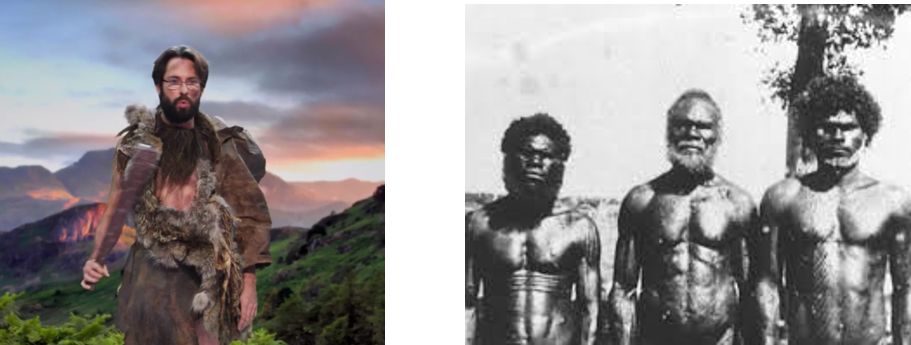
Do they look happy and healthy? They aren’t smiling. But, they certainly look healthier and fitter than their average modern counterpart. Head-to-head, I would definitely put my money on one of them over Nye’s cavemen – with or without the club.
But again, let’s forgive the costume.
Let’s instead focus on the message. Nye’s caveman continued his rant pointing to himself and saying, “this is not healthy, I’m seventeen.” The underlying message of his rant is that he is representative of the health and happiness of millennia of hunter-gatherer civilizations.
And that’s where Nye crosses a line. Putting a 40-year-old man in a dollar Halloween store caveman get-up is funny. Using that joke as evidence to completely misrepresent entire civilizations seems a little classless.
So, I can forgive the costume, but I can’t forgive the implications. Nye and his caveman make flippant and bold claims about hunter-gatherer health, happiness, and aging without evidence, and in direct contradiction of the established science. Simplifying the science to make it entertaining isn’t an excuse for getting it wrong; especially for someone who’s talent is to make science digestible to the masses.
So, let’s look at what the science really says about his claims. And let’s do it in mostly simple terms to show that the true science is digestible. Nye and his caveman make four arguments against The Paleo Diet. First that the diet is all protein which is dangerous. Second, that Nye’s caveman is 17-years-old and “not healthy,” implying that hunter-gatherers aged very rapidly and poorly. Third, that their diet didn’t help with disease because our paleolithic ancestors did not live long enough to suffer from now common conditions like cancer and heart attacks. And finally, that the caveman is clearly unhappy living a Paleo life.
I could address that final argument with dozens of accounts of how tribal cultures centered around their regular feast and the joy experienced at these community events. But you know what, that would be a lot of energy focused on addressing a bad joke. Forget the science—I’m just going to recommend Nye takes a couple hours to watch Dances with Wolves.
Bill Nye Gets Hunter-Gatherer Aging and Health Wrong
Let’s address the second and third arguments: first that hunter-gatherers aged rapidly and poorly and second, that they didn’t live long enough to develop cancer and other degenerative diseases. These are common misconceptions easily disproved by current science.
Yes, the average life-expectancy of ancient hunter-gatherer societies was somewhere between 20-years of age and late 30s [1-6]. But that does not mean, as Nye implies, that 30-year-olds looked like frail modern-day 80-year-olds.
Life expectancy and aging are two very different things. Life expectancy is determined using a complex multi-factorial equation that considers all causes of death including illness, accidents and war. It also factors in mortality rates of children, full-grown adults and the elderly. Delve deeper and you have to understand things like senescence, life tables and mortality hazard rates [6].
That’s a mouthful, and not something that Nye’s audience should have to understand—but Nye should.
Put simply, life expectancy says very little if anything about the aging process. If life expectancy was 30, that does not mean that people died of old age at 30. War, disease, and high childhood mortality all affect the number. In fact, the biggest factor in life expectancy is childhood mortality. Life expectancy in hunter-gatherer societies were so much lower than modern day societies because the rates of childhood mortality were very high, as this graph of Hiwi hunter-gatherers shows [2]:
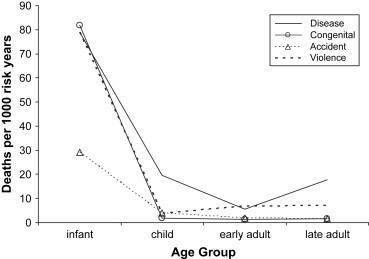
In 2007, Michael Gurven, PhD and Hillard Kaplan, PhD published the most extensive study of hunter-gatherer life expectancy and longevity to date. And they used actual records of deaths from multiple recent hunter-gatherer societies instead of calculations and theory like previous studies.
Showing just how big a factor childhood mortality was, they compared mortality rates of their hunter-gatherer societies to modern Americans [6]:
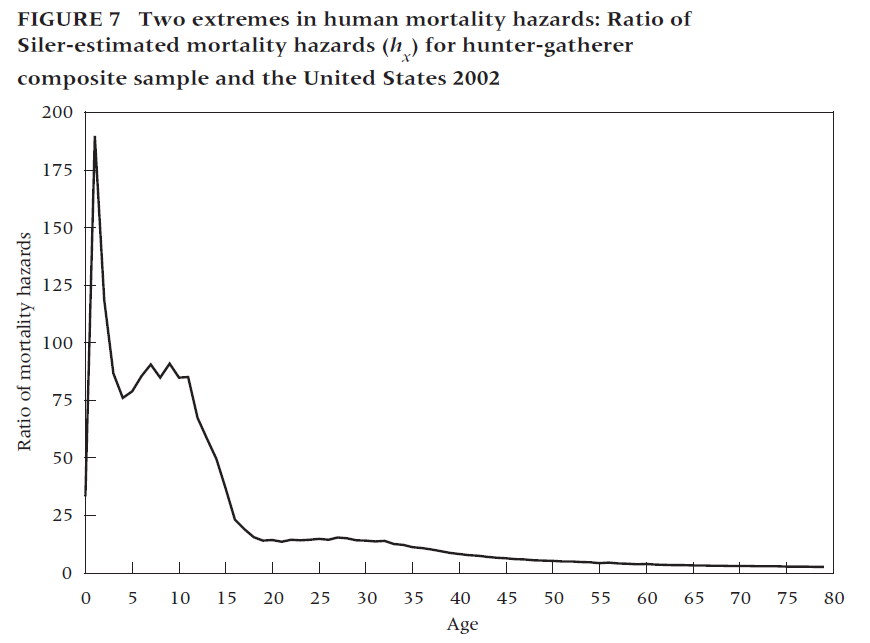
What this graph shows, simply, is that mortality rates in childhood are up to 100 times higher in hunter-gatherers than modern humans. But for those who lived past the age of 15, their life-expectancy was very similar to modern humans.
Gurven and Kaplan concluded their study by stating:
Our results contradict Vallois’s claim that among early humans, “few individuals passed forty years, and it is only quite exceptional that any passed fifty”… The data shows that modal adult life span is 68-78 years and that it was not uncommon for individuals to reach these ages, suggesting that inferences based on paleodemographic reconstruction are unreliable.
In other words, claims that life was short was based on unreliable data. Hunter-gatherers who survived to the age of 15 in fact aged no faster than modern humans and frequently lived into their 70s.
A better way to estimate the age at which people tended to die of old age is modal age. Sorry again for the complex term. Simply put, it’s the most common age of death. Gurven and Kaplan determined the modal ages for modern Americans and for both recent and ancient hunter-gatherers:
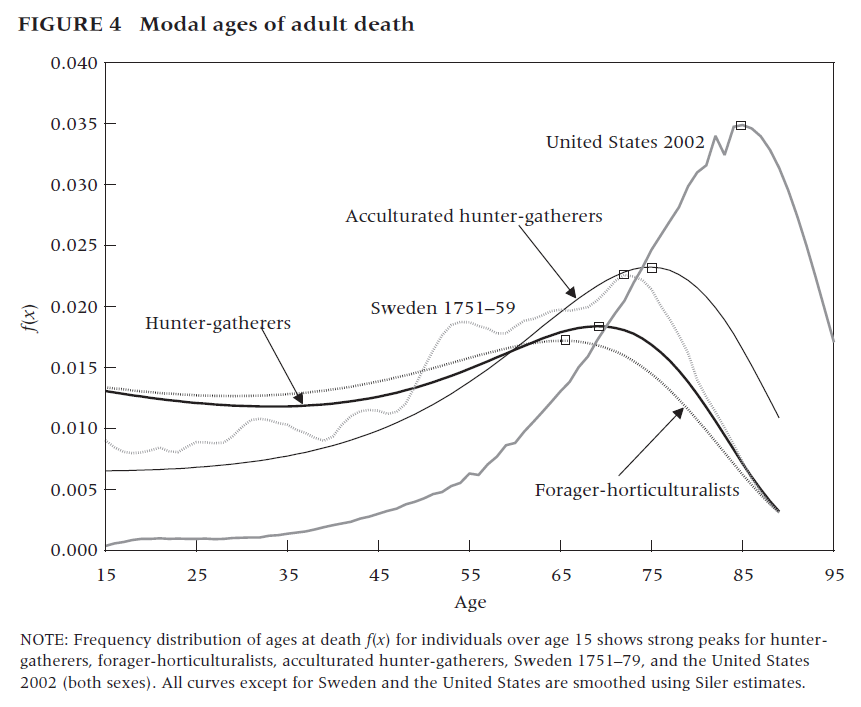
While modern Americans have the highest model age of death, the differences are not that great. The modal adult life span ranged from 68-78 years for pre-modern societies [6].
Nye’s failure to understand this accepted science about aging and life span led to his other mistaken argument. He claimed that while our Paleolithic ancestors had few chronic diseases, it was because no one lived long enough to contract them and not because of lifestyle or diet.
Gurven and Kaplan explored causes of death as well. They divided the causes into four categories: illness (such as respiratory infection and gastrointestinal problems,) accidents, violence, and degenerative deaths (cancer, heart disease, old-age.) Gurven and Kaplan, admitted that chronic illness was hard to diagnose in these societies. However, since the other three causes accounted for, on average, 90.8% of deaths, degenerative death was at most a minor factor at 9.2% [6]. Even in those who survived to old age, degeneration still only accounted for 28.2% of deaths in adults over 60 years of age.
Contrast those rates to the 2015 Center For Disease Control statistics on the top 10 causes of death in America where the seven leading degenerative conditions (heart disease, cancer, stroke, Alzheimer’s disease, diabetes, and nephritis) accounted for 59.4% of deaths [7]:
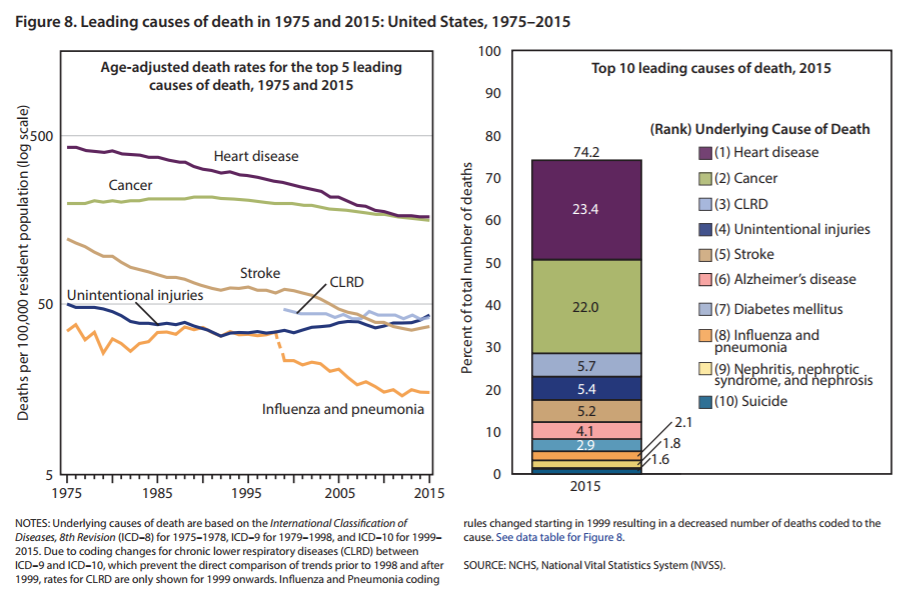
It’s important to recognize that this higher percentage in modern Americans is due in part or mostly to a drop in deaths due to illness, injury and violence and not just a rise in chronic disease.
However, contradicting Nye’s claim that chronic illness is purely an old-age phenomena, among adults aged 25-44, the four top degenerative conditions alone (including cancer) accounted for 30% of deaths in America in 2015 [7]. Death rates were similar between hunter-gatherers and modern Americans in this age range [6] yet for hunter-gatherers, all degenerative diseases accounted for only 9.2% of deaths in adults aged 15 to 59 [6].
The fact is, if the appearance of chronic disease was purely due to people living longer, then we wouldn’t have had a dramatic rise in these conditions in recent decades including a rise in childhood cancer, diabetes, and other chronic conditions. [4, 5, 8-12]. Chronic disease among US children increased from 12.8% in 1994 to 26.6% in 2006 alone [12]. A rise that corresponds more with dietary changes like the increase in high-carbohydrate diets and refined sugars.
Gurven and Kaplan wrote that “degenerative deaths are relatively few, confined largely to problems early in infancy and late-age cerebrovascular problems, as well as attribution of ‘old-age’ in the absence of obvious symptoms… heart attack and stroke appear rare and do not account for these old-age deaths.”
The general good health was also reflected in Captain Cook’s account of the native Maori during his 1772 expedition to New Zealand:
A further proof that human nature here is untainted with disease is the great number of old men that we saw… appeared to be very ancient, yet none of them were decrepit; and though not equal to the young in muscular strength, were not a whit behind them in cheerfulness and vivacity.
Simply put, hunter-gatherers lived a much longer, healthier and happier life than Bill Nye claimed. We have a wealth of ethnographic science to show this. He has an actor with a club.
Bill Nye Gets the Paleo Diet Wrong… and Nutrition in General
Nye very correctly states that an all-protein diet is dangerous. Dr. Loren Cordain even wrote in the original Paleo Diet book that consuming more than about 35% of our calories from protein can lead to a fatal condition called rabbit starvation [4].
However, the fact that Nye believes the Paleo Diet is an all-protein diet demonstrates that he didn’t bother to research the diet before attacking it. He also makes some very basic nutrition mistakes. Even if hunter-gatherers ate only meat (which they didn’t), meat is not all-protein. It’s often not even predominantly protein. It contains fat—a macronutrient that Nye failed to even mention. Yet, the types of fat we eat have a profound impact on our health.
Hunter-gatherer diets in fact ranged from 19-35% protein and 22-40% carbohydrate [13]. Further, about 35-45% of hunter-gatherer’s total calories came from fruits and vegetables. And since meat is far more calorie dense, hunter-gatherers ate a greater volume of carbohydrate-rich plant food than meat [14].
Nye continued to demonstrate a lack of understanding of basic nutrition by saying that “eating Paleo means giving up pasta, breads: carbohydrates.”
Again, this is basic nutrition. Grains are not our only carbohydrate source. Vegetables and fruits are considered carbohydrate sources as well. They are also more nutrient dense than grain products, and even Paleo-detractors will generally agree that fresh vegetables are healthier than bread and pasta [4, 5, 13, 15, 16].
So yes, an all-protein, all-meat diet is bad for you. But what does that have to do with The Paleo Diet or basic nutrition in general? I challenge Nye to eat an all-protein diet. I’m not sure it’s physiologically possible.
Bill Nye Is Trying to Save the World
Nye has publicly stated his support for a vegan diet. And don’t get me wrong; I admire vegans when they are doing it for ethical or sustainability reasons. Sustainability is a legitimate concern and Dr. Cordain has published a paper stating that the world’s population has exceeded what can be supported on a Paleo Diet [17].
My co-thesis advisor researched beans and rice. She claimed a few times that “Trevor is working with Dr. Cordain to help figure out what’s the healthiest diet. I’m trying to figure out how to feed the world.”
But, supporting a vegan diet for sustainability reasons doesn’t also automatically make it healthier. Nor does it make the diet our bodies evolved around less healthy. It’s noble for a scientist to want to “save the world” and maybe a little cocky to name your show that. But no scientist will save anything by getting the basic science wrong.
References
1. Karasik, D., B. Arensburg, and O.M. Pavlovsky, Age assessment of Natufian remains from the land of Israel. American Journal of Physical Anthropology, 2000. 113(2): p. 263-274.
2. Hill, K., A.M. Hurtado, and R.S. Walker, High adult mortality among Hiwi hunter-gatherers: Implications for human evolution. Journal of Human Evolution, 2007. 52(4): p. 443-454.
3. Trinkaus, E., Late Pleistocene adult mortality patterns and modern human establishment. Proceedings of the National Academy of Sciences of the United States of America, 2011. 108(4): p. 1267-1271.
4. Cordain, L., The Paleo diet : lose weight and get healthy by eating the foods you were designed to eat. Rev. ed. 2011, Hoboken, N.J.: Wiley. xv, 266 p.
5. Eaton, S.B., M. Konner, and M. Shostak, Stone agers in the fast lane: chronic degenerative diseases in evolutionary perspective. Am J Med, 1988. 84(4): p. 739-49.
6. Gurven, M. and H. Kaplan, Longevity among hunter-gatherers: A cross-cultural examination. Population and Development Review, 2007. 33(2): p. 321-365.
7. Statistics, N.C.f.H., Health, United States, 2016: With Chartbook on Long-term Trends in Health, U.D.o.H.a.H. Services, Editor. 2017. p. 488.
8. Anderson, G. and J. Horvath, The growing burden of chronic disease in America. Public Health Rep, 2004. 119(3): p. 263-70.
9. Gale, E.A., The rise of childhood type 1 diabetes in the 20th century. Diabetes, 2002. 51(12): p. 3353-61.
10. Eaton, S.B., L. Cordain, and P.B. Sparling, Evolution, body composition, insulin receptor competition, and insulin resistance. Prev Med, 2009. 49(4): p. 283-5.
11. Eaton, S.B. and M. Konner, Paleolithic nutrition. A consideration of its nature and current implications. N Engl J Med, 1985. 312(5): p. 283-9.
12. Van Cleave, J., S.L. Gortmaker, and J.M. Perrin, Dynamics of Obesity and Chronic Health Conditions Among Children and Youth. Jama-Journal of the American Medical Association, 2010. 303(7): p. 623-630.
13. Cordain, L., et al., Origins and evolution of the Western diet: health implications for the 21st century. Am J Clin Nutr, 2005. 81(2): p. 341-54.
14. Cordain, L., et al., Plant-animal subsistence ratios and macronutrient energy estimations in worldwide hunter-gatherer diets. Am J Clin Nutr, 2000. 71(3): p. 682-92.
15. Cordain, L., et al., Macronutrient estimations in hunter-gatherer diets. Am J Clin Nutr, 2000. 72(6): p. 1589-92.
16. Eaton, S.B. and S.B. Eaton, 3rd, Paleolithic vs. modern diets–selected pathophysiological implications. Eur J Nutr, 2000. 39(2): p. 67-70.
17. Cordain, L., Cereal grains: humanity’s double-edged sword. World Rev Nutr Diet, 1999. 84: p. 19-73.
